It’s a wonderful world — and universe — out there.
Come explore with us!

Science News Explores
Let’s learn about surviving a trip to mars.
Astronauts would face dangers both getting to and surviving on the Red Planet
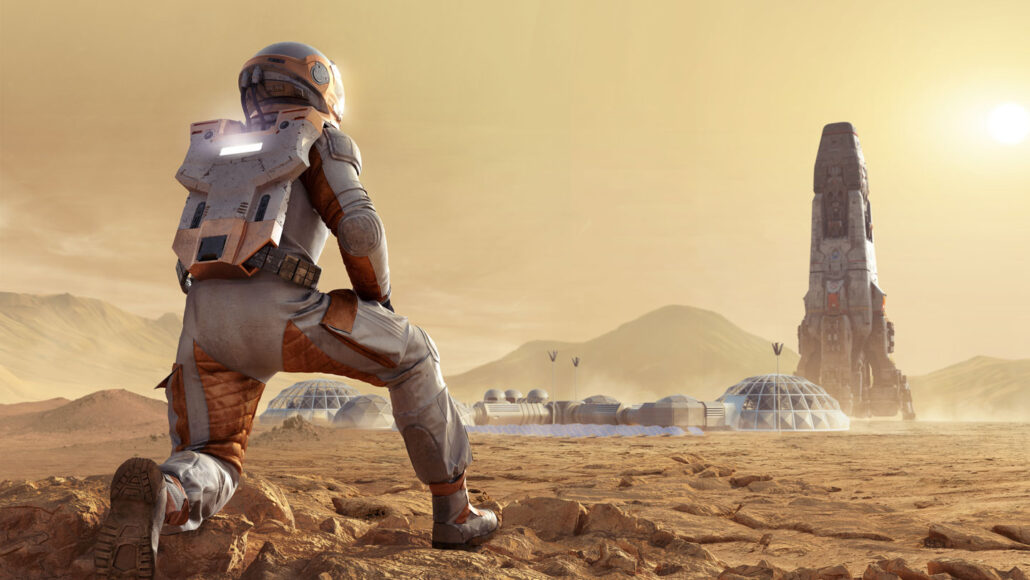
A trip to Mars may be many years off. But scientists are already figuring out what it would take to keep people safe and healthy on a journey to the Red Planet.
peepo/E+/Getty Images
Share this:
- Google Classroom
By Maria Temming
July 12, 2022 at 6:30 am
So far, Mars has been the domain of space robots . Over the last 60 years, many spacecraft have flown by, orbited and even landed on the Red Planet. But human explorers could work faster and be more flexible than machines. Not to mention, setting foot on Mars would be a major milestone in space exploration. That’s why the United States, China and other countries want to send people to Mars . But surviving this adventure would be no easy feat.
A Mars mission would be the farthest journey in human history. At an average 225 million kilometers (140 million miles) away, Mars would take at least six months for astronauts to reach. (It would take at least another six months to get back home). In contrast, Apollo astronauts got to the moon in few days.
While space travel is never free of danger, the length of a roundtrip to Mars poses many extra health risks . For one thing, floating in microgravity for long periods weakens bones and muscles. Plus, it allows fluid to build up in the head, putting pressure behind the eyes and causing vision problems. Artificial gravity machines could help.
But then there’s space radiation to worry about. The Earth’s magnetic field protects astronauts near Earth from high-energy cosmic rays . Those charged particles might raise the risk of cancer and other health problems. On longer journeys, though, astronauts would be exposed for months. Taking certain vitamins could reduce the impacts. But scientists are still working out the details.
Mars explorers will have to pack light to lift off from Earth. But they won’t be able to restock on supplies like astronauts on the space station do. Astronauts on the space station practice for this by growing lettuce and other food in space . Engineers are also developing 3-D printing techniques that could let future Mars astronauts build tools as needed. The material for those tools could come from the astronauts themselves. For instance, astronaut pee could feed yeast that churns out ingredients to make plastic .
Educators and Parents, Sign Up for The Cheat Sheet
Weekly updates to help you use Science News Explores in the learning environment
Thank you for signing up!
There was a problem signing you up.
Setting up and surviving at a Mars colony would be even more complicated. Since astronauts can’t haul construction materials from Earth, scientists are dreaming up ways for astronauts to use materials on Mars . Long-term visitors would also need plenty of oxygen to breathe. A device on NASA’s Perseverance rover is currently laying the groundwork for a future Mars oxygen factory. The device pries oxygen off molecules of carbon dioxide , the main gas in Mars’ atmosphere.
Planning for a trip to Mars isn’t just about protecting astronauts. It’s also about protecting Mars from astronauts. Humans are teeming with microbes. And spreading those microbes could compromise the search for life on Mars. As a result, a key part of responsible space exploration is making sure Earth germs don’t infect other planets .
Want to know more? We’ve got some stories to get you started:
Preparing for that trip to Mars Space farming techniques, next-generation rockets and 3-D printing could all factor into a successful trip to Mars. (2/22/2018) Readability: 6.6
Surviving Mars missions will take planning and lots of innovation En route to Mars, astronauts will face health risks from microgravity, radiation and more. (10/22/2020) Readability: 8.0
How a year in space affected Scott Kelly’s health A comparison to his twin looks at how long-term spaceflight changes the human body. (5/17/2019) Readability: 7.3
Explore more
Scientists Say: Microgravity
Explainer: Gravity and microgravity
Let’s learn about Mars
Let’s learn about gravity
The ultimate getaway — visiting the Red Planet
Analyze This: Insect shells could help builders on Mars
En route to Mars, astronauts may face big health risks
The Perseverance rover split CO2 on Mars to make breathable air
What to wear on Mars
Want a tougher space suit? Just add liquid
Here’s how a new sleeping bag could protect astronauts’ eyesight
Space travel may harm health by damaging cells’ powerhouses
Staying grounded in space requires artificial gravity
Human waste could power plastic-making in space
Keeping space missions from infecting Earth and other worlds
Design your own sustainable Mars colony with guidance from NASA. Take inspiration from communities on Earth and learn about the limitations of the Martian environment to build a model of your ideal human base on the Red Planet. Or, follow NASA’s instructions to build your own model Mars’ rover .
More Stories from Science News Explores on Space
Explainer: what is the solar cycle.

Scientists Say: Corona

Get ready for the 2024 total solar eclipse

Let’s learn about meteorites

Scientists Say: Solar Cycle

The weird sky glow called STEVE is really confusing scientists

This space physicist uses radios to study eclipses

Huge polygons on Mars hint its equator may once have been frozen
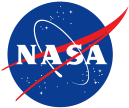
- Mars Rock Samples
- Mars Weather
- Where is Perseverance?
- Explore with Perseverance
- Landing Site
- Mission Team
- Surface Operations
- Instruments
- Rover Updates
- Watch Online
- More Resources
- You've Got Perseverance!
- Roving With Perseverance
- Send Your Name to Mars
- Sounds of Mars
- Mars Photo Booth
- #CountdownToMars
- Name the Rover
- Mars Exploration Home
- Mars Sample Return
- Mars Helicopter
- Mars Science Laboratory
- Mars Reconnaissance Orbiter
- Mars Odyssey
- InSight Mission
- Mars Exploration Rovers
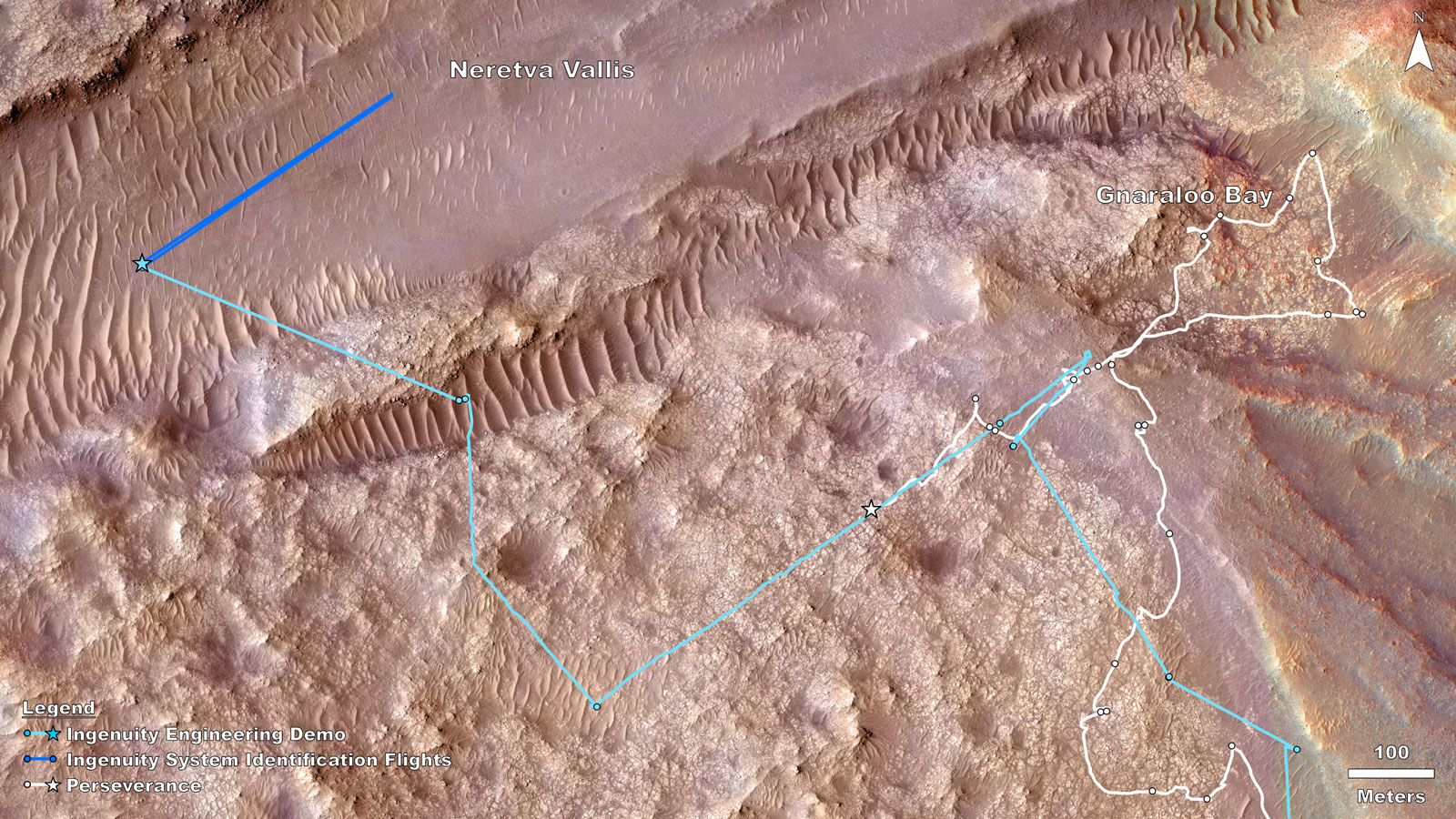
Unlocking the Martian Skies
Nowhere on Earth can we fully replicate the conditions on Mars. READ MORE
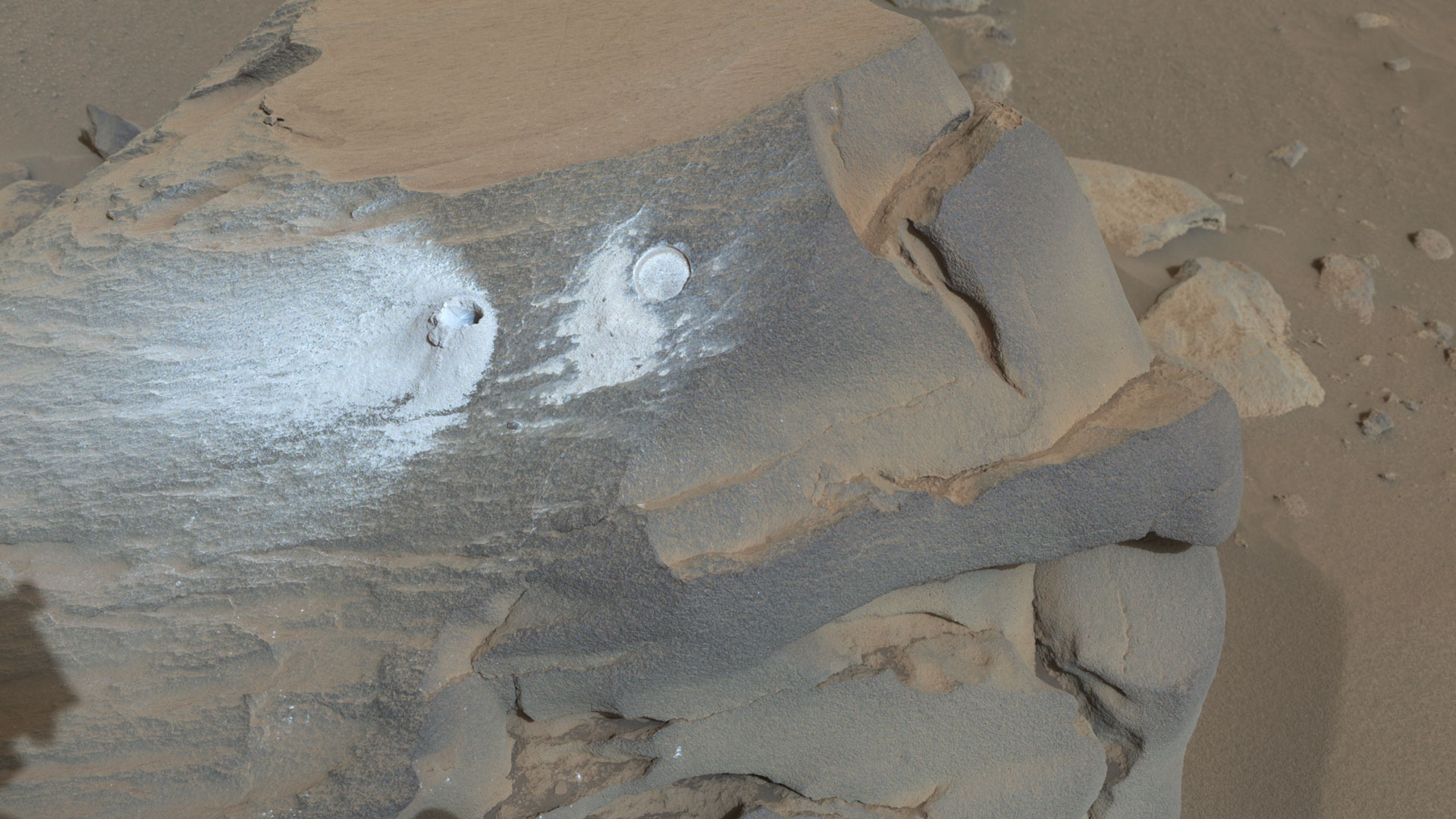
Rock Sampled by NASA's Perseverance Embodies Why Rover Came to Mars
The 24th sample taken by the six-wheeled scientist offers new clues about Jezero Crater and the lake it may have once held. Read Article Mars Rock Samples

Perseverance Pays off When Studying the Martian Atmosphere
Studying the atmosphere with Perseverance can be challenging! Imagine spotting an interesting cloud in a photo taken yesterday; unlike something interesting on the surface, more observations just aren't possible, as it's long gone by now. READ MORE
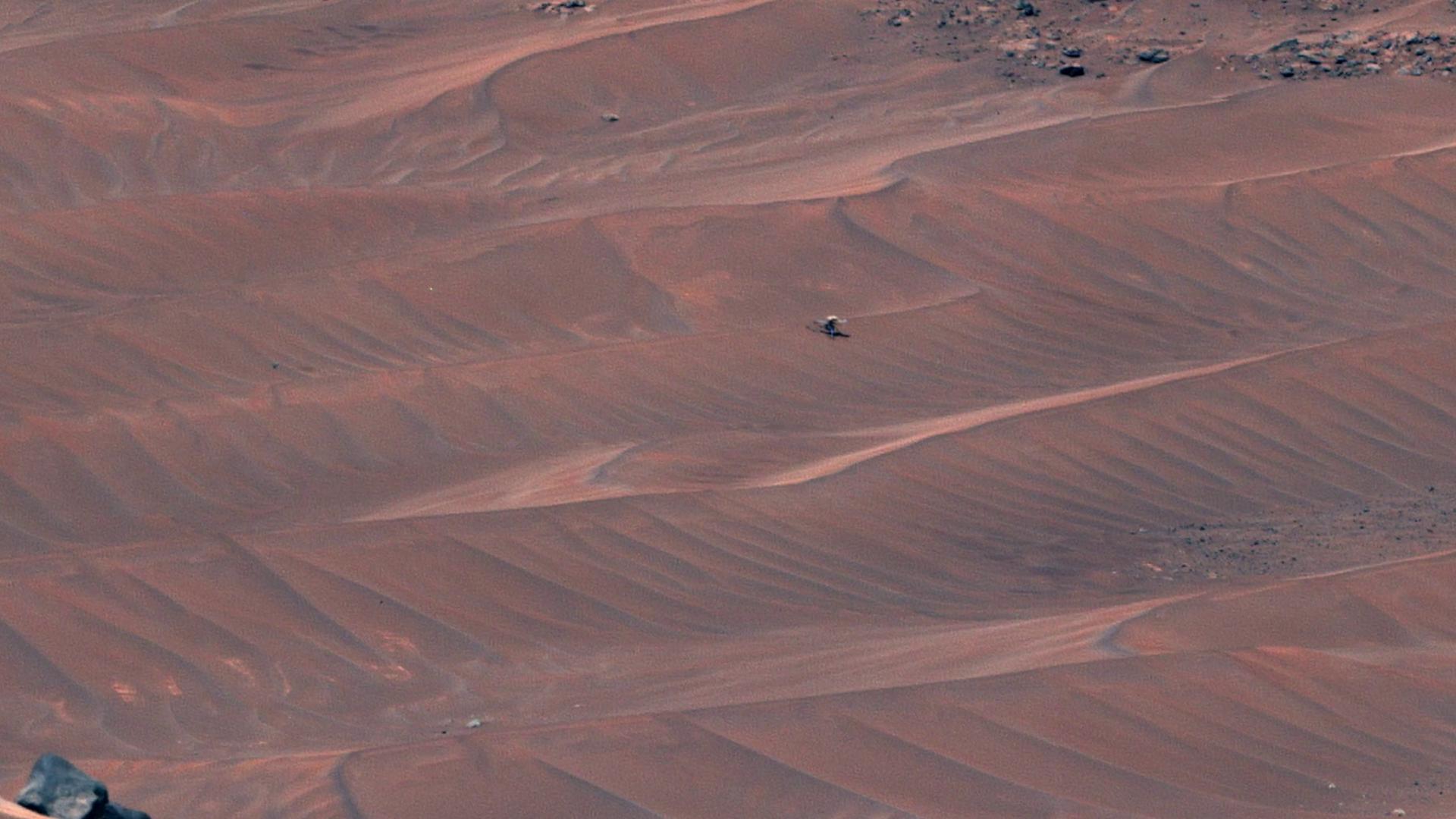
Rover Images Ingenuity's Final Destination
Perseverance rover imagery of the Ingenuity helicopter on the Mars surface shows the damaged rotor blade that led to the conclusion of the highly successful helicopter mission after three years and 72 flights. Spot the Helicopter Related Article Image Gallery
Quick Facts

- Mission Name: Mars 2020
- Rover Name: Perseverance
- Main Job: Seek signs of ancient life and collect samples of rock and regolith (broken rock and soil) for possible return to Earth.
- Launch: July 30, 2020
- Landing: Feb. 18, 2021, Jezero Crater, Mars
- Helicopter: The Mars Helicopter completed its 30-day technology demonstration and continues in its operations demo phase.
- Explore the Rover in 3D
See the latest weather report from the Perseverance rover at Jezero Crater.

Missed your chance to fly with Perseverance? Sign up to send your name with a future Mars mission.

Blog updates written by Mars Perseverance mission team members.

See the latest images the Perseverance rover sends back here. Vote for your favorite to become "Image of the Week."

This web experience lets you hear what a person might sound like on the Red Planet. You can even record your own greeting and hear how you'd sound on Mars.

Location Map for Perseverance
Explore Jezero Crater using this interactive map that lets you zoom in and see where the Perseverance rover is located. VIEW MAP
Learn more about the diverse set of samples the rover has collected, which could one day be returned to Earth by Mars Sample Return.
View Rock Samples
MARS PERSEVERANCE
Image of the Week
Meet the martians.
Meet some of the team members behind the Perseverance rover
MORE PROFILES

View in VR and 360°
Explore Jezero Crater using this interactive map that lets you zoom in and see where the Perseverance rover is located. VIEW INTERACTIVE EXPERIENCE
Meet Our Robots

This site is maintained by the Mars Communications Team at NASA's Jet Propulsion Laboratory for NASA's Science Mission Directorate
Mars Communications Manager : Claire Powell
NASA Official : Debra Hernandez
Site Manager : Melody Ho
Editor : Jane Platt
CL# : 19-6952

- PHOTO GALLERY
4 Years on Mars: Curiosity's Incredible Journey in Pictures
Four years after its harrowing descent through Mars's thin atmosphere, Curiosity celebrates its action-packed journey.
Four Earth-years ago today, NASA’s Curiosity rover successfully touched ground on Mars's dusty surface, after surviving a nail-biting descent through the red planet's thin atmosphere.
Since its triumphant arrival, the car-size "laboratory on wheels" has traveled more than 8.4 miles (13.5 kilometers), taking pictures, collecting samples, and analyzing rocks along the way. Recent software upgrades even let Curiosity autonomously choose which rocks it examines— and shoots with laser beams .
Curiosity has spent more than 1,421 sols, or Martian days, exploring Gale Crater , a low-lying region that may have held past life, if it existed. While the rover has yet to confirm whether Mars once hosted living things, it has found evidence of an ancient freshwater lake in the sediments of Yellowknife Bay, the lowest point of the crater, offering tantalizing insight into the planet's past habitability.
Since September 2014, Curiosity has been examining Mount Sharp, a mountain of layered rocks towering more than three miles (five kilometers) high in the middle of Gale Crater.
These layers likely "captured a long record of time, just like the layers in the Grand Canyon," said Ashwin Vasavada, Curiosity's deputy project scientist, in a previous interview .
Beyond examining rocks, Curiosity has a suite of weather instruments that has been providing scientists with crucial information about the planet. For instance, researchers are tracking changes in methane in the Martian atmosphere, which fluctuates by up to a factor of 10 for unknown reasons. The rover also monitors the peculiar flow of winds inside the large basin of Gale Crater, and it keeps tabs on radiation exposure on Mars, which may affect future human missions to the red planet.
Even after four years— and a recent software scare —the rover is healthy and has a lot of life in it. Speaking from the rover's perspective a year ago, "we don't feel like we are getting old yet," said Vasavada. "We still feel like we have a lot ahead of us."
Maya Wei-Hass contributed reporting.
Follow Michael Greshko on Twitter .
FREE BONUS ISSUE
Related topics.
- EXPLORATION
You May Also Like

Why signs of life on Mars remain so mysterious

Why are people so dang obsessed with Mars?

See how people have imagined life on Mars through history

A raging river and frost-tipped dunes reveal watery history on Mars

How helicopters are shaking up the hunt for life on Mars
- Environment
- Paid Content
History & Culture
- History & Culture
- History Magazine
- Gory Details
- 2023 in Review
- Mind, Body, Wonder
- Terms of Use
- Privacy Policy
- Your US State Privacy Rights
- Children's Online Privacy Policy
- Interest-Based Ads
- About Nielsen Measurement
- Do Not Sell or Share My Personal Information
- Nat Geo Home
- Attend a Live Event
- Book a Trip
- Inspire Your Kids
- Shop Nat Geo
- Visit the D.C. Museum
- Learn About Our Impact
- Support Our Mission
- Advertise With Us
- Customer Service
- Renew Subscription
- Manage Your Subscription
- Work at Nat Geo
- Sign Up for Our Newsletters
- Contribute to Protect the Planet
Copyright © 1996-2015 National Geographic Society Copyright © 2015-2024 National Geographic Partners, LLC. All rights reserved
How NASA is planning to get humans to Mars
The upcoming Artemis II mission is the first step in a long mission
- Newsletter sign up Newsletter
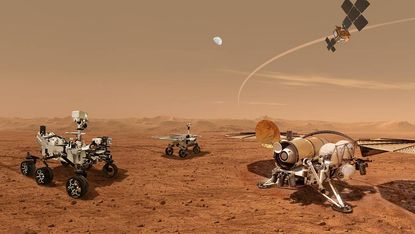
NASA recently announced the crew of its upcoming Artemis II mission, which will be the first manned trip to the moon since 1972. The launch is being billed as the first step toward getting humans to Mars , but how does NASA plan to do that? Here's everything you need to know:
How will NASA get to Mars?
The journey will start with the Artemis program, which has the goal of establishing the first long-term human outpost on the moon. From there, NASA says , they "will use what we learn on and around the moon to take the next giant leap: sending the first astronauts to Mars."
In 2022, NASA unveiled a rough outline for its first crewed Mars mission, identifying "50 points falling under four overarching categories of exploration, including transportation and habitation; moon and Mars infrastructure; operations; and science." These objectives "will inform our exploration plans at the moon and Mars for the next 20 years," said NASA Deputy Administrator Pam Melroy.
Subscribe to The Week
Escape your echo chamber. Get the facts behind the news, plus analysis from multiple perspectives.

Sign up for The Week's Free Newsletters
From our morning news briefing to a weekly Good News Newsletter, get the best of The Week delivered directly to your inbox.
These objectives include , among other things, "[Developing] a transportation system that can deliver large surface elements from Earth to the Martian surface," as well as "[developing] Mars surface power sufficient for the initial human Mars demonstration mission," and building "entry, descent, and landing (EDL) systems capable of delivering crew and large cargo to the Martian surface."
However, there is still a ton of work to be done, as making a human trip to Mars "will be challenging," Space.com writes. The distance itself will play a major factor. Earth and Mars are an average of 140 million miles away from each other, and it would take about 500 days round-trip to get between the two planets, "assuming the funding and technology come into play at the right time," the outlet adds. A lack of gravity would also pose a significant problem, so crews may have to live in a pressurized cabin during the mission to help acclimatize to the change.
If all goes well — and that is a big "if" — Space.com notes that NASA "envisions using a habitat-like spacecraft to ferry crew members to the red planet, using a hybrid rocket stage (powered by both chemical and electrical propulsion)." The initial mission would be made by four people, with two making the journey to the Martian surface. But since you can't live on a desolate planet by yourself, NASA estimates the crew would need at least 25 tons of supplies awaiting them on Mars, which will have been delivered by a prior rover mission.
How will Artemis II help accomplish this goal?
The mission, set to launch toward the end of 2024, will be the first crewed flight of the Orion spacecraft, the vessel that has been tapped to send humans to Mars. Both the Orion and the Space Launch System (SLS) associated with it "are critical to NASA's exploration plans at the moon and beyond," the agency writes .
The Orion capsule is specifically designed to keep humans alive during months-long missions, and "will be equipped with advanced environmental control and life support systems designed for the demands of a deep space mission," per NASA . The first step in proving that these systems are viable will be a successful Artemis II mission, which CNN reports will go beyond the moon and "potentially further than any human has traveled in history."
The upcoming mission is only a flyby, and while humans will not land on the moon until Artemis III, operating on the lunar surface requires "systems that can reliably operate far from home, support the needs of human life, and still be light enough to launch," NASA writes. As a result, "exploration of the moon and Mars is intertwined," with the moon providing a platform to test "tools, instruments, and equipment that could be used on Mars ."
When does NASA plan to go to Mars?
That could depend on how fast things develop. In 2017, then-President Donald Trump signed an order directing NASA to send humans to Mars by 2033, and former President Barack Obama had set a similar goal of a mission in the 2030s, CNET reports.
NASA Administrator Bill Nelson pushed that date back slightly, saying the agency's plan "is for humans to walk on Mars by 2040," per CNN . Nelson added that the goal was to apply "what we've learned living and operating on the moon and continue them out into the solar system."
President Biden's budget proposal for the next fiscal year included an allocation of $27 billion to NASA, of which $7.6 billion would be used for deep-space exploration. However, negotiations on a budget deal are ongoing between Congress and the White House, so it remains to be seen how much of these potential NASA funds will actually see the light of day.
Who will go?
That probably won't be decided for years to come. Former NASA Administrator Jim Bridenstine said in 2019 that "we could very well see the first person on Mars be a woman," per Space.com , but no specifics regarding an astronaut class were given. Artemis III is expected to land both the first woman and first person of color on the moon, so it won't come as much of a surprise if a similarly diverse group heads to the red planet. Elon Musk, who has worked alongside NASA via his spaceflight company SpaceX, has said he believes humans will be on Mars by 2029 at the latest, but he hasn't provided any names either.
For now, though, the question of who will be the first person to place their boots on the Martian surface remains a mystery.
Sign up for Today's Best Articles in your inbox
A free daily email with the biggest news stories of the day – and the best features from TheWeek.com
Justin Klawans has worked as a staff writer at The Week since 2022. He began his career covering local news before joining Newsweek as a breaking news reporter, where he wrote about politics, national and global affairs, business, crime, sports, film, television and other Hollywood news. Justin has also freelanced for outlets including Collider and United Press International.

Today's Big Question It's a chance for Donald Trump to block Joe Biden's path to re-election
By Joel Mathis, The Week US Published 11 April 24

Instant Opinion Opinion, comment and editorials of the day
By Harold Maass, The Week US Published 11 April 24

Speed Read These American women reshaped the work force during World War II
By Peter Weber, The Week US Published 11 April 24

The Explainer A new sex gene could be on the evolution pipeline
By Devika Rao, The Week US Published 14 March 24
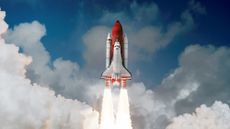
In depth To infinity and beyond!
By Devika Rao, The Week US Published 8 March 24

The Explainer One giant leap for mankind
By Devika Rao, The Week US Published 6 March 24

The Explainer Some asteroids are valued at £100trn-plus but mining them is easier said than done
By Austin Chen, The Week UK Published 22 February 24

In Depth From photos of the infant universe to an energy advancement that could save the planet
By Devika Rao, The Week US Published 31 January 24
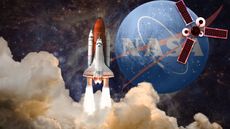
In Depth A running list of the space agency's most exciting developments
By Devika Rao, The Week US Published 19 January 24

The Explainer Meteor showers, eclipses and more are coming to the skies

Speed Read New data adds 40 million years to the satellite's age
By Devika Rao, The Week US Published 25 October 23
- Contact Future's experts
- Terms and Conditions
- Privacy Policy
- Cookie Policy
- Advertise With Us
The Week is part of Future plc, an international media group and leading digital publisher. Visit our corporate site . © Future US, Inc. Full 7th Floor, 130 West 42nd Street, New York, NY 10036.

- Park Overview Explore Missions Zones
- Heroes and Legends Space Pioneers
- Behind the Gates Kennedy Space Center Bus Tour
- Race to the Moon Apollo Moon Landing
- Shuttle: A Ship Like No Other NASA's Space Shuttle Program
- NASA Now + Next Preparing for Journey to Mars
- All Attractions
- Plan Your Visit
- Hours Of Operation
- Hotel Packages
- Travel Information
- Events Overview
- Event Calendar
- See A Launch
- Groups Overview Plan Events and Tours
- Youth Groups Programs and Field Trips
- Scouts Adventures for Scout Troops
- Private Events Events and Custom Tours
- International Programs and Custom Tours
- Camp KSC Day Camp for Students
- Educators Resources for Teachers
- Programs Educational Programs at KSC
- Accessibility Information

Mars Needs Recruits
Are you fascinated by the possibility of exploring the Red Planet? Discover NASA’s plans to explore deep space, including Mars, asteroids and once again, the Moon. This multimedia exhibit includes a live presentation and highlights what’s happening at NASA right now. Test your deep space savvy with interactive games and simulators and explore replicas of Mars rovers.

Heroes & Legends
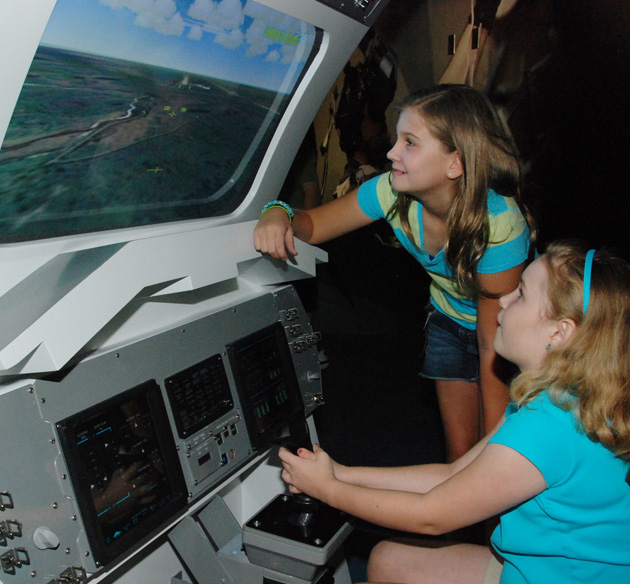
Astronaut Training Simulators
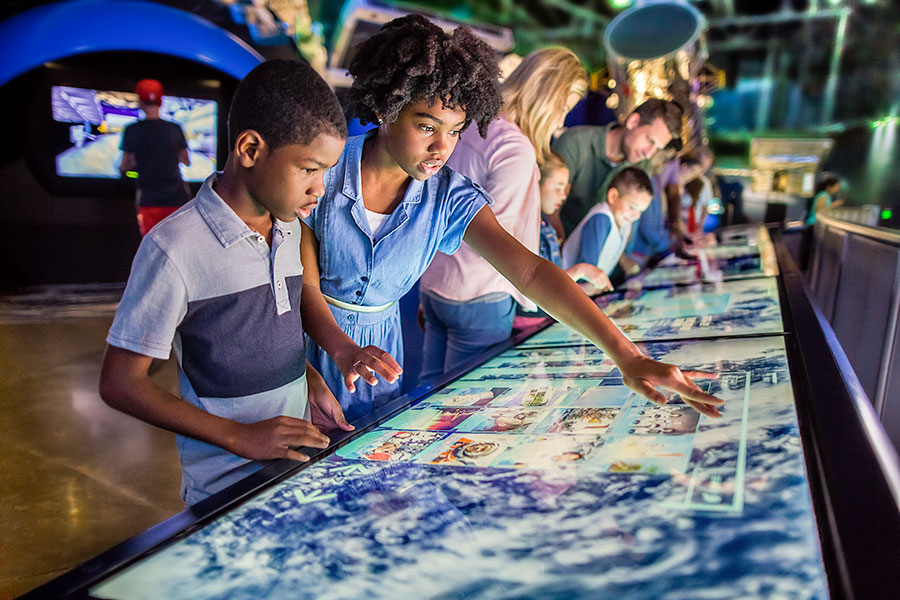
PLAN YOUR MISSION

SpaceX plans to leave the first humans on Mars stranded with no way home
Spacex has presented some key details for its upcoming missions to mars and how the company will navigate the journey with starship..

SpaceX has conducted a presentation at its Starbase facility in Boca Chica, Texas, revealing some key details about its upcoming Mars missions that will feature the world's most powerful rocket, Starship.
The company's CEO, Elon Musk, has taken to stage to discuss what fans of SpaceX can expect out of the company in 2024 and what will be involved in creating a sustainable presence on the surface of Mars. Musk said that this is the first time in human civilization that Earth is capable of making the species multiplanetary, and all of this hinges of the success of Starship, the world's largest and most powerful rocket ever created.
Musk outlines that mass to orbit is a key factor in achieving a Mars base, and when Starship is complete, it will be capable of taking 200 tons to orbit while being fully reusable. The SpaceX CEO explains that once Starship is in orbit, it will need to be refueled by a tanker that's also in orbit. This new technology will be called Ship to Ship Propellent Transfer, and for every trip to Mars, Starship will need to be refueled six times, so a ratio of 5 to 1. Musk said that SpaceX plans on demonstrating Ship to Ship Propellent Transfer sometime next year.
" You actually want to use the ship. Take a part the ship and use it for raw materials on Mars. Because the ship materials will be so valuable, most of the ships you won't want to bring back, you would just want to use them for raw materials. Eventually we will want to bring ships back and I think we will want to give people the option of coming back because they're more likely to want to go if there's some option of coming back. But I think most of the people that go to Mars will never come back to Earth, " said Musk during the presentation (skip to 23:00)
Additionally, Musk said that Starship's ship will be turned into scrap metal once it lands on Mars as its parts will be extremely valuable to the pioneers living on the Red Planet. Ultimately, the company plans on creating a Starship that is capable of making a return trip back to Earth, but initially Musk believes most people who sign up for a trip to Mars will not return to Earth.
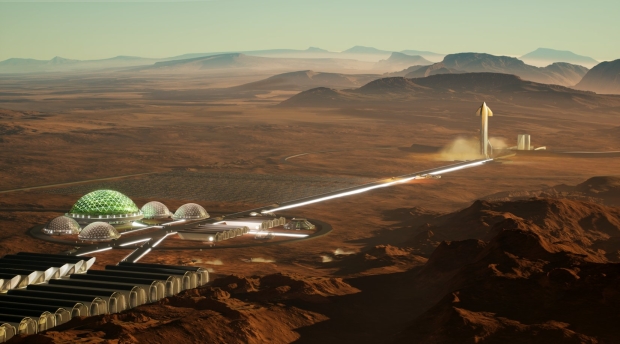
$25 PlayStation Store Gift Card [Digital Code]

Jak joined the TweakTown team in 2017 and has since reviewed 100s of new tech products and kept us informed daily on the latest science, space, and artificial intelligence news. Jak's love for science, space, and technology, and, more specifically, PC gaming, began at 10 years old. It was the day his dad showed him how to play Age of Empires on an old Compaq PC. Ever since that day, Jak fell in love with games and the progression of the technology industry in all its forms. Instead of typical FPS, Jak holds a very special spot in his heart for RTS games.
What's in Jak's PC?
- CPU: AMD Ryzen 5 5600X
- MOTHERBOARD: ASUS ROG Crosshair VIII HERO (WiFi)
- RAM: G.Skill Trident Z Neo 32GB CL16 DDR4 3600MHz 32GB (2 x 16GB)
- GPU: NVIDIA GeForce RTX 4090 Founders Edition
- SSD: GALAX HOF Pro SSD PCI-E M.2 2TB, Samsung SSD 850 EVO 250GB
- OS: Windows 11 Pro
- COOLER: NZXT Kraken 360mm AIO
- CASE: Lian Li Lancool III
- PSU: Corsair RM1000x SHIFT 80 PLUS Gold
- KEYBOARD: Logitech G915 LIGHTSPEED
- MOUSE: Logitech G PRO Wireless
- MONITOR: MSI MAG 274UPF 4K 144Hz
Similar News

Related Tags
- SpaceX Mars
- Starship launch

What If You Were the First Person on Mars?
Posted: April 12, 2024 | Last updated: April 12, 2024
Congratulations, you've taken the seven-month-long journey and have landed on Mars. And it turns out, you're the first person. Better start getting the human colonization efforts prepared.Will you ever make it back to Earth? How will you gather resources for survival? And will this happen one day?Transcript and sources: <a href="https://insh.world/science/what-if-you-were-the-first-person-on-mars/Made">https://insh.world/science/what-if-you-were-the-first-person-on-mars/Made</a> possible with the support of Ontario Creates <a href="http://www.ontariocreates.caWatch">http://www.ontariocreates.caWatch</a> more what-if scenarios: Planet Earth: <a href="https://www.youtube.com/watch?v=_-HhCwYD7rc&list=PLZdXRHYAVxTJCzxwmCq0NNpYq9N9wyb2lThe">https://www.youtube.com/watch?v=_-HhCwYD7rc&list=PLZdXRHYAVxTJCzxwmCq0NNpYq9N9wyb2lThe</a> Cosmos: <a href="https://www.youtube.com/watch?v=gfuJyVkMH_g&list=PLZdXRHYAVxTJno6oFF9nLGuwXNGYHmE8UTechnology:">https://www.youtube.com/watch?v=gfuJyVkMH_g&list=PLZdXRHYAVxTJno6oFF9nLGuwXNGYHmE8UTechnology:</a> <a href="https://www.youtube.com/watch?v=CS3bBO05fpU&list=PLZdXRHYAVxTIeRY3JtgXgoGqSEB7kDdKOYour">https://www.youtube.com/watch?v=CS3bBO05fpU&list=PLZdXRHYAVxTIeRY3JtgXgoGqSEB7kDdKOYour</a> Body: <a href="https://www.youtube.com/watch?v=QmXR46TrbA8&list=PLZdXRHYAVxTJNsV9FFeNAKl2ySsHj8GZOHumanity:">https://www.youtube.com/watch?v=QmXR46TrbA8&list=PLZdXRHYAVxTJNsV9FFeNAKl2ySsHj8GZOHumanity:</a> <a href="https://www.youtube.com/watch?v=fdCDQIyXGnw&list=PLZdXRHYAVxTIFnvmOeWbv-Mt8zFxSCSvZFollow">https://www.youtube.com/watch?v=fdCDQIyXGnw&list=PLZdXRHYAVxTIFnvmOeWbv-Mt8zFxSCSvZFollow</a> what-if on Instagram for bonus material: <a href="https://www.instagram.com/what.if.show/Suggest">https://www.instagram.com/what.if.show/Suggest</a> an episode: <a href="http://bit.ly/suggest-whatifT-shirts">http://bit.ly/suggest-whatifT-shirts</a> and merch: <a href="http://bit.ly/whatifshopFacebook">http://bit.ly/whatifshopFacebook</a> Watch: <a href="https://www.facebook.com/What.If.scienceWatch">https://www.facebook.com/What.If.scienceWatch</a> on Tubi: <a href="http://bit.ly/what-if-tubi"Imagination">http://bit.ly/what-if-tubi"Imagination</a> will often carry us to worlds that never were. But without it, we go nowhere." — Carl SaganIf you enjoy What If, make sure to check out our other channel "Underknown": <a href="https://www.youtube.com/c/interestingshitProduced">https://www.youtube.com/c/interestingshitProduced</a> by Underknown in Toronto, What If is a mini-documentary web series that takes you on an epic journey through hypothetical worlds and possibilities. Join us on an imaginary adventure — grounded in scientific theory — through time, space and chance, as we ask what if some of the most fundamental aspects of our existence were different.Feedback, inquiries and suggestions: <a href="https://underknown.com/contact">https://underknown.com/contact</a>
More for You
Michael J. Fox Says ‘We Used to Bust Our Ass' to Be Famous and ‘You Had to Be Talented,' but Now It's: ‘What's That Dance Step? And You're the Most Famous Person in the World'
‘I haven’t seen something like that in the skies here’ Robertson reports from Jerusalem
New doc uncovers racism and inappropriate behavior at popular retailer
The Best Big Bang Theory Blooper of Every Season
I Walked 20k Steps a Day for a Month. The Results Transformed Me
Carnival, Royal Caribbean rival makes huge beverage change
'Beetlejuice Beetlejuice' Trailer: Michael Keaton & Winona Ryder Meet Again, Jenna Ortega Joins Ghastly Family | THR News Video
Star Trek Origin Movie Confirmed by Paramount, Logline Revealed
Boeing’s CEO search has a new frontrunner—and insiders say it could mean a radical change for the $104 billion ailing planemaker
British intelligence: Putin's military bribery attempt could have consequences
I Lost 50lbs With 3 Lifestyle Changes
The best thrillers to watch on Netflix this April
Pushups are an efficient, full-body exercise — but don't make this 1 mistake
Keanu Reeves' Ballerina Cameo as John Wick Revealed at CinemaCon Screening
Volunteer group tackles removal of popular but invasive tree: 'Now things that belong to this land can grow'
These 5 PC upgrades are the biggest money wasters
I Lost 100lbs by Following 4 Rules
NCIS - We Owe It To Him
Sam's Club makes a key move designed to trump Costco
CBS daytime show 'The Talk' ending with shortened 15th season this fall
- Share full article
For more audio journalism and storytelling, download New York Times Audio , a new iOS app available for news subscribers.

- April 12, 2024 • 34:23 How One Family Lost $900,000 in a Timeshare Scam
- April 11, 2024 • 28:39 The Staggering Success of Trump’s Trial Delay Tactics
- April 10, 2024 • 22:49 Trump’s Abortion Dilemma
- April 9, 2024 • 30:48 How Tesla Planted the Seeds for Its Own Potential Downfall
- April 8, 2024 • 30:28 The Eclipse Chaser
- April 7, 2024 The Sunday Read: ‘What Deathbed Visions Teach Us About Living’
- April 5, 2024 • 29:11 An Engineering Experiment to Cool the Earth
- April 4, 2024 • 32:37 Israel’s Deadly Airstrike on the World Central Kitchen
- April 3, 2024 • 27:42 The Accidental Tax Cutter in Chief
- April 2, 2024 • 29:32 Kids Are Missing School at an Alarming Rate
- April 1, 2024 • 36:14 Ronna McDaniel, TV News and the Trump Problem
- March 29, 2024 • 48:42 Hamas Took Her, and Still Has Her Husband
How One Family Lost $900,000 in a Timeshare Scam
A mexican drug cartel is targeting seniors and their timeshares..
Hosted by Katrin Bennhold
Produced by Asthaa Chaturvedi and Will Reid
With Clare Toeniskoetter and Lynsea Garrison
Edited by Brendan Klinkenberg and Michael Benoist
Original music by Marion Lozano , Rowan Niemisto , Dan Powell , Pat McCusker and Will Reid
Engineered by Chris Wood
Listen and follow The Daily Apple Podcasts | Spotify | Amazon Music
Warning: this episode contains descriptions of violence.
A massive scam targeting older Americans who own timeshare properties has resulted in hundreds of millions of dollars sent to Mexico.
Maria Abi-Habib, an investigative correspondent for The Times, tells the story of a victim who lost everything, and of the criminal group making the scam calls — Jalisco New Generation, one of Mexico’s most violent cartels.
On today’s episode

Maria Abi-Habib , an investigative correspondent for The New York Times based in Mexico City.

Background reading
How a brutal Mexican drug cartel came to target seniors and their timeshares .
There are a lot of ways to listen to The Daily. Here’s how.
We aim to make transcripts available the next workday after an episode’s publication. You can find them at the top of the page.
The Daily is made by Rachel Quester, Lynsea Garrison, Clare Toeniskoetter, Paige Cowett, Michael Simon Johnson, Brad Fisher, Chris Wood, Jessica Cheung, Stella Tan, Alexandra Leigh Young, Lisa Chow, Eric Krupke, Marc Georges, Luke Vander Ploeg, M.J. Davis Lin, Dan Powell, Sydney Harper, Mike Benoist, Liz O. Baylen, Asthaa Chaturvedi, Rachelle Bonja, Diana Nguyen, Marion Lozano, Corey Schreppel, Rob Szypko, Elisheba Ittoop, Mooj Zadie, Patricia Willens, Rowan Niemisto, Jody Becker, Rikki Novetsky, John Ketchum, Nina Feldman, Will Reid, Carlos Prieto, Ben Calhoun, Susan Lee, Lexie Diao, Mary Wilson, Alex Stern, Dan Farrell, Sophia Lanman, Shannon Lin, Diane Wong, Devon Taylor, Alyssa Moxley, Summer Thomad, Olivia Natt, Daniel Ramirez and Brendan Klinkenberg.
Our theme music is by Jim Brunberg and Ben Landsverk of Wonderly. Special thanks to Sam Dolnick, Paula Szuchman, Lisa Tobin, Larissa Anderson, Julia Simon, Sofia Milan, Mahima Chablani, Elizabeth Davis-Moorer, Jeffrey Miranda, Renan Borelli, Maddy Masiello, Isabella Anderson and Nina Lassam.
Katrin Bennhold is the Berlin bureau chief. A former Nieman fellow at Harvard University, she previously reported from London and Paris, covering a range of topics from the rise of populism to gender. More about Katrin Bennhold
Advertisement

Suggested Searches
- Climate Change
- Expedition 64
- Mars perseverance
- SpaceX Crew-2
- International Space Station
- View All Topics A-Z
Humans in Space
Earth & climate, the solar system, the universe, aeronautics, learning resources, news & events.

NASA’s PACE Data on Ocean, Atmosphere, Climate Now Available

Altitude Chamber Gets Upgrade for Artemis II, Spacecraft Testing Begins

NASA Next-Generation Solar Sail Boom Technology Ready for Launch
- Search All NASA Missions
- A to Z List of Missions
- Upcoming Launches and Landings
- Spaceships and Rockets
- Communicating with Missions
- James Webb Space Telescope
- Hubble Space Telescope
- Why Go to Space
- Astronauts Home
- Commercial Space
- Destinations
- Living in Space
- Explore Earth Science
- Earth, Our Planet
- Earth Science in Action
- Earth Multimedia
- Earth Science Researchers
- Pluto & Dwarf Planets
- Asteroids, Comets & Meteors
- The Kuiper Belt
- The Oort Cloud
- Skywatching
- The Search for Life in the Universe
- Black Holes
- The Big Bang
- Dark Energy & Dark Matter
- Earth Science
- Planetary Science
- Astrophysics & Space Science
- The Sun & Heliophysics
- Biological & Physical Sciences
- Lunar Science
- Citizen Science
- Astromaterials
- Aeronautics Research
- Human Space Travel Research
- Science in the Air
- NASA Aircraft
- Flight Innovation
- Supersonic Flight
- Air Traffic Solutions
- Green Aviation Tech
- Drones & You
- Technology Transfer & Spinoffs
- Space Travel Technology
- Technology Living in Space
- Manufacturing and Materials
- Science Instruments
- For Kids and Students
- For Educators
- For Colleges and Universities
- For Professionals
- Science for Everyone
- Requests for Exhibits, Artifacts, or Speakers
- STEM Engagement at NASA
- NASA's Impacts
- Centers and Facilities
- Directorates
- Organizations
- People of NASA
- Internships
- Our History
- Doing Business with NASA
- Get Involved
- Aeronáutica
- Ciencias Terrestres
- Sistema Solar
- All NASA News
- Video Series on NASA+
- Newsletters
- Social Media
- Media Resources
- Upcoming Launches & Landings
- Virtual Events
- Sounds and Ringtones
- Interactives
- STEM Multimedia

The April 8 Total Solar Eclipse: Through the Eyes of NASA

NASA’s Boeing Crew Flight Test Mission Overview

Hubble Spots a Galaxy Hidden in a Dark Cloud

NASA Shares Medical Expertise with New Space Station Partners

From NASA’s First Astronaut Class to Artemis II: The Importance of Military Jet Pilot Experience

The Ocean Touches Everything: Celebrate Earth Day with NASA

Earth Day Poster 2024
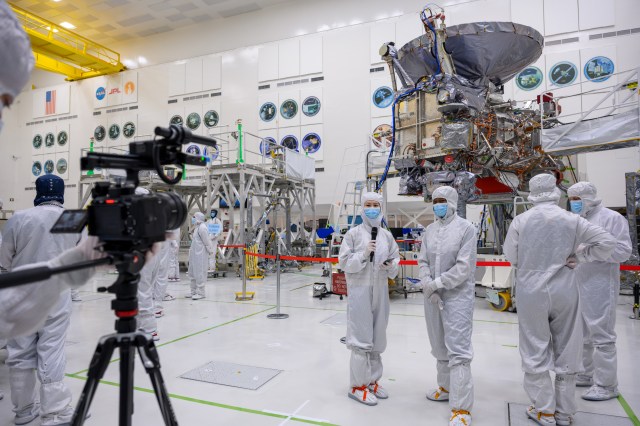
Media Get Close-Up of NASA’s Jupiter-Bound Europa Clipper

More Than 36,000 Volunteers Helped Do NASA Eclipse Science

NASA’s TESS Temporarily Pauses Science Observations

NASA Names Finalists of the Power to Explore Challenge
Earth Day 2024: Posters and Virtual Backgrounds

NASA Langley Team to Study Weather During Eclipse Using Uncrewed Vehicles

ARMD Solicitations

NASA Noise Prediction Tool Supports Users in Air Taxi Industry

Tech Today: Folding NASA Experience into an Origami Toolkit

NASA’s SERT II: ‘A Genuine Space Success Story’

NASA Partnerships Bring 2024 Total Solar Eclipse to Everyone

Shawnta M. Ball Turns Obstacles into Opportunities in Goddard’s Education Office

A Langley Intern Traveled 1,340 Miles to View a Total Solar Eclipse. Here’s What She Saw.

La presentación del X-59 de la NASA personifica la tradición aeronáutica
10 min read
Real Martians: How to Protect Astronauts from Space Radiation on Mars
Sarah Frazier

Miles Hatfield

On Aug. 7, 1972, in the heart of the Apollo era, an enormous solar flare exploded from the sun’s atmosphere. Along with a gigantic burst of light in nearly all wavelengths, this event accelerated a wave of energetic particles. Mostly protons, with a few electrons and heavier elements mixed in, this wash of quick-moving particles would have been dangerous to anyone outside Earth’s protective magnetic bubble. Luckily, the Apollo 16 crew had returned to Earth just five months earlier, narrowly escaping this powerful event.
In the early days of human space flight, scientists were only just beginning to understand how events on the sun could affect space, and in turn how that radiation could affect humans and technology. Today, as a result of extensive space radiation research, we have a much better understanding of our space environment, its effects, and the best ways to protect astronauts—all crucial parts of NASA’s mission to send humans to Mars.
“The Martian” film highlights the radiation dangers that could occur on a round trip to Mars. While the mission in the film is fictional, NASA has already started working on the technology to enable an actual trip to Mars in the 2030s. In the film, the astronauts’ habitat on Mars shields them from radiation, and indeed, radiation shielding will be a crucial technology for the voyage. From better shielding to advanced biomedical countermeasures, NASA currently studies how to protect astronauts and electronics from radiation – efforts that will have to be incorporated into every aspect of Mars mission planning, from spacecraft and habitat design to spacewalk protocols.
“The space radiation environment will be a critical consideration for everything in the astronauts’ daily lives, both on the journeys between Earth and Mars and on the surface,” said Ruthan Lewis, an architect and engineer with the human spaceflight program at NASA’s Goddard Space Flight Center in Greenbelt, Maryland. “You’re constantly being bombarded by some amount of radiation.”
Radiation, at its most basic, is simply waves or sub-atomic particles that transports energy to another entity – whether it is an astronaut or spacecraft component. The main concern in space is particle radiation. Energetic particles can be dangerous to humans because they pass right through the skin, depositing energy and damaging cells or DNA along the way. This damage can mean an increased risk for cancer later in life or, at its worst, acute radiation sickness during the mission if the dose of energetic particles is large enough.
Fortunately for us, Earth’s natural protections block all but the most energetic of these particles from reaching the surface. A huge magnetic bubble, called the magnetosphere, which deflects the vast majority of these particles, protects our planet. And our atmosphere subsequently absorbs the majority of particles that do make it through this bubble. Importantly, since the International Space Station (ISS) is in low-Earth orbit within the magnetosphere, it also provides a large measure of protection for our astronauts.
“We have instruments that measure the radiation environment inside the ISS, where the crew are, and even outside the station,” said Kerry Lee, a scientist at NASA’s Johnson Space Center in Houston.
This ISS crew monitoring also includes tracking of the short-term and lifetime radiation doses for each astronaut to assess the risk for radiation-related diseases. Although NASA has conservative radiation limits greater than allowed radiation workers on Earth, the astronauts are able to stay well under NASA’s limit while living and working on the ISS, within Earth’s magnetosphere.
But a journey to Mars requires astronauts to move out much further, beyond the protection of Earth’s magnetic bubble.
“There’s a lot of good science to be done on Mars, but a trip to interplanetary space carries more radiation risk than working in low-Earth orbit,” said Jonathan Pellish, a space radiation engineer at Goddard.
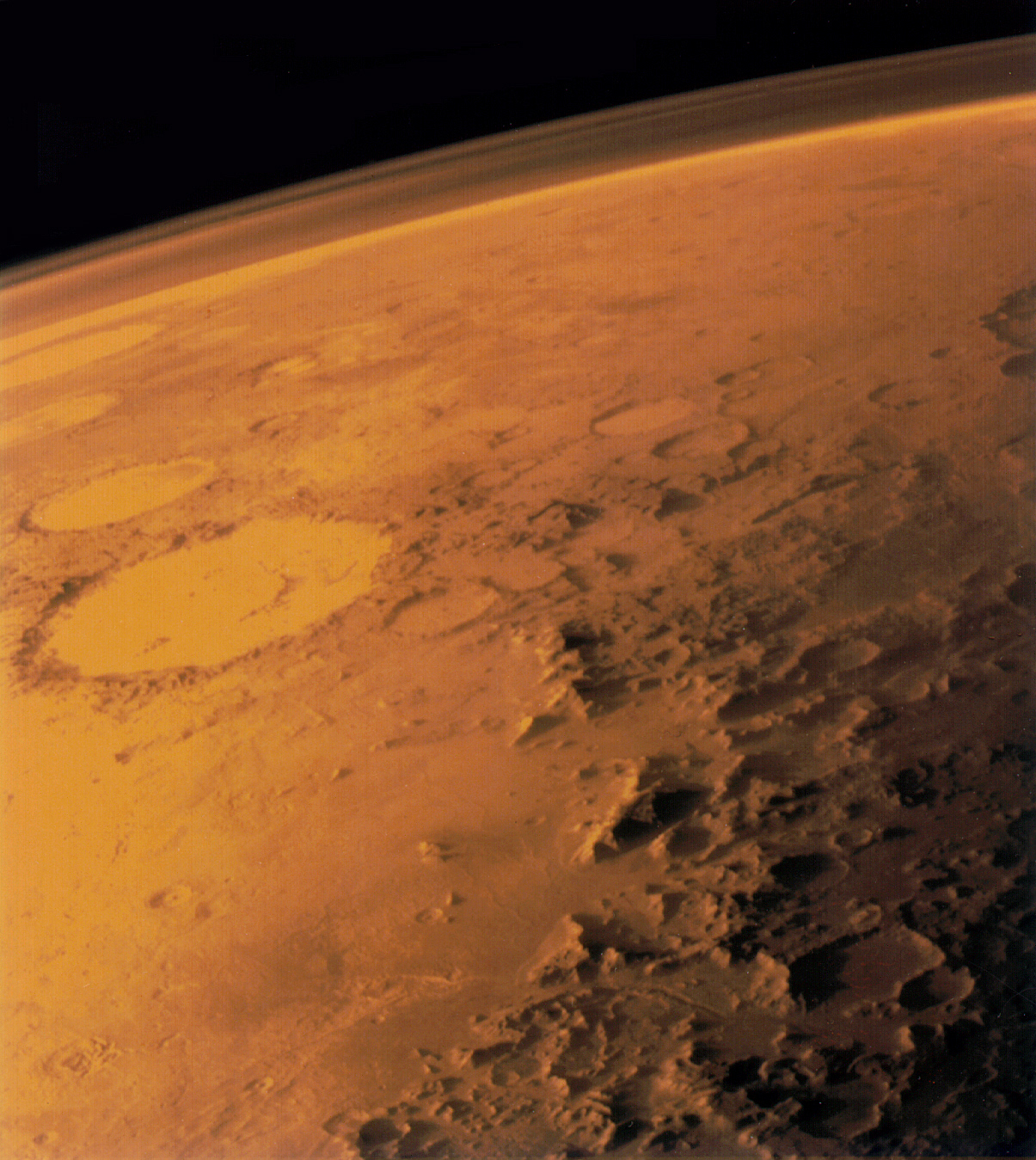
A human mission to Mars means sending astronauts into interplanetary space for a minimum of a year, even with a very short stay on the Red Planet. Nearly all of that time, they will be outside the magnetosphere, exposed to the harsh radiation environment of space. Mars has no global magnetic field to deflect energetic particles, and its atmosphere is much thinner than Earth’s, so they’ll get only minimal protection even on the surface of Mars.
Throughout the entire trip, astronauts must be protected from two sources of radiation. The first comes from the sun, which regularly releases a steady stream of solar particles, as well as occasional larger bursts in the wake of giant explosions, such as solar flares and coronal mass ejections, on the sun. These energetic particles are almost all protons, and, though the sun releases an unfathomably large number of them, the proton energy is low enough that they can almost all be physically shielded by the structure of the spacecraft.
Since solar activity strongly contributes to the deep-space radiation environment, a better understanding of the sun’s modulation of this radiation environment will allow mission planners to make better decisions for a future Mars mission. NASA currently operates a fleet of spacecraft studying the sun and the space environment throughout the solar system. Observations from this area of research, known as heliophysics, help us better understand the origin of solar eruptions and what effects these events have on the overall space radiation environment.
“If we know precisely what’s going on, we don’t have to be as conservative with our estimates, which gives us more flexibility when planning the mission,” said Pellish.
The second source of energetic particles is harder to shield. These particles come from galactic cosmic rays, often known as GCRs. They’re particles accelerated to near the speed of light that shoot into our solar system from other stars in the Milky Way or even other galaxies. Like solar particles, galactic cosmic rays are mostly protons. However, some of them are heavier elements, ranging from helium up to the heaviest elements. These more energetic particles can knock apart atoms in the material they strike, such as in the astronaut, the metal walls of a spacecraft, habitat, or vehicle, causing sub-atomic particles to shower into the structure. This secondary radiation, as it is known, can reach a dangerous level.
There are two ways to shield from these higher-energy particles and their secondary radiation: use a lot more mass of traditional spacecraft materials, or use more efficient shielding materials.
The sheer volume of material surrounding a structure would absorb the energetic particles and their associated secondary particle radiation before they could reach the astronauts. However, using sheer bulk to protect astronauts would be prohibitively expensive, since more mass means more fuel required to launch.
Using materials that shield more efficiently would cut down on weight and cost, but finding the right material takes research and ingenuity. NASA is currently investigating a handful of possibilities that could be used in anything from the spacecraft to the Martian habitat to space suits.
“The best way to stop particle radiation is by running that energetic particle into something that’s a similar size,” said Pellish. “Otherwise, it can be like you’re bouncing a tricycle off a tractor-trailer.”
Because protons and neutrons are similar in size, one element blocks both extremely well—hydrogen, which most commonly exists as just a single proton and an electron. Conveniently, hydrogen is the most abundant element in the universe, and makes up substantial parts of some common compounds, such as water and plastics like polyethylene. Engineers could take advantage of already-required mass by processing the astronauts’ trash into plastic-filled tiles used to bolster radiation protection. Water, already required for the crew, could be stored strategically to create a kind of radiation storm shelter in the spacecraft or habitat. However, this strategy comes with some challenges—the crew would need to use the water and then replace it with recycled water from the advanced life support systems.
Polyethylene, the same plastic commonly found in water bottles and grocery bags, also has potential as a candidate for radiation shielding. It is very high in hydrogen and fairly cheap to produce—however, it’s not strong enough to build a large structure, especially a spacecraft, which goes through high heat and strong forces during launch. And adding polyethylene to a metal structure would add quite a bit of mass, meaning that more fuel would be required for launch.
“We’ve made progress on reducing and shielding against these energetic particles, but we’re still working on finding a material that is a good shield and can act as the primary structure of the spacecraft,” said Sheila Thibeault, a materials researcher at NASA’s Langley Research Center in Hampton, Virginia.
One material in development at NASA has the potential to do both jobs: Hydrogenated boron nitride nanotubes—known as hydrogenated BNNTs—are tiny, nanotubes made of carbon, boron, and nitrogen, with hydrogen interspersed throughout the empty spaces left in between the tubes. Boron is also an excellent absorber secondary neutrons, making hydrogenated BNNTs an ideal shielding material.

“This material is really strong—even at high heat—meaning that it’s great for structure,” said Thibeault.
Remarkably, researchers have successfully made yarn out of BNNTs, so it’s flexible enough to be woven into the fabric of space suits, providing astronauts with significant radiation protection even while they’re performing spacewalks in transit or out on the harsh Martian surface. Though hydrogenated BNNTs are still in development and testing, they have the potential to be one of our key structural and shielding materials in spacecraft, habitats, vehicles, and space suits that will be used on Mars.
Physical shields aren’t the only option for stopping particle radiation from reaching astronauts: Scientists are also exploring the possibility of building force fields. Force fields aren’t just the realm of science fiction: Just like Earth’s magnetic field protects us from energetic particles, a relatively small, localized electric or magnetic field would—if strong enough and in the right configuration—create a protective bubble around a spacecraft or habitat. Currently, these fields would take a prohibitive amount of power and structural material to create on a large scale, so more work is needed for them to be feasible.
The risk of health effects can also be reduced in operational ways, such as having a special area of the spacecraft or Mars habitat that could be a radiation storm shelter; preparing spacewalk and research protocols to minimize time outside the more heavily-shielded spacecraft or habitat; and ensuring that astronauts can quickly return indoors in the event of a radiation storm.
Radiation risk mitigation can also be approached from the human body level. Though far off, a medication that would counteract some or all of the health effects of radiation exposure would make it much easier to plan for a safe journey to Mars and back.
“Ultimately, the solution to radiation will have to be a combination of things,” said Pellish. “Some of the solutions are technology we have already, like hydrogen-rich materials, but some of it will necessarily be cutting edge concepts that we haven’t even thought of yet.”
Sarah Frazier NASA’s Goddard Space Flight Center , Greenbelt, Md.

IMAGES
VIDEO
COMMENTS
The trip to Mars will take about seven months and about 300 million miles (480 million kilometers). During that journey, engineers have several opportunities to adjust the spacecraft's flight path, to make sure its speed and direction are best for arrival at Jezero Crater on Mars. The first tweak to the spacecraft's flight path happens ...
Get ready to embark on an incredible interplanetary adventure with '10 Years On Mars: The Full Journey of Curiosity', a feature-length documentary that bring...
A Mars mission would be the farthest journey in human history. At an average 225 million kilometers (140 million miles) away, Mars would take at least six months for astronauts to reach. (It would take at least another six months to get back home). In contrast, Apollo astronauts got to the moon in few days. See all the entries from our Let's ...
Rover Name: Perseverance. Main Job: Seek signs of ancient life and collect samples of rock and regolith (broken rock and soil) for possible return to Earth. Launch: July 30, 2020. Landing: Feb. 18, 2021, Jezero Crater, Mars. Helicopter: The Mars Helicopter completed its 30-day technology demonstration and continues in its operations demo phase.
Just before 4 p.m. eastern time, the hulking, multibillion-dollar NASA rover Perseverance landed safely on the red planet after a 300-million-mile journey and a nerve-racking plunge to the Martian ...
Four years after its harrowing descent through Mars's thin atmosphere, Curiosity celebrates its action-packed journey. Four Earth-years ago today, NASA's Curiosity rover successfully touched ...
"A lot of it is also to bring you along on our journey, our touchdown to Mars and, of course, our surface mission as well," said Michael M. Watkins, the director of the Jet Propulsion ...
Temperatures on Mars can range from -284 degrees F to 86 degrees F. The atmosphere on Mars is 96% carbon dioxide. One day on Mars lasts about 37 minutes longer than an Earth day. A year on Mars is almost twice as long as a year on Earth. Gravity on Mars is about one-third of the gravity on Earth. If you weigh 100 pounds on Earth, you would ...
Watch an epic journey unfold on Thursday, Feb. 18 as our Perseverance rover lands on Mars. To reach the surface of the Red Planet, the rover has to survive t...
Perseverance released two images after its successful landing on Thursday. NASA TV. The second of two images sent by Perseverance from Mars's surface. NASA TV. All that anyone on Earth could do ...
LANDING ON MARS. Starship will enter Mars' atmosphere at 7.5 kilometers per second and decelerate aerodynamically. The vehicle's heat shield is designed to withstand multiple entries, but given that the vehicle is coming into Mars' atmosphere so hot, we still expect to see some ablation of the heat shield (similar to wear and tear on a brake pad).
A journey of about six months, Mars is a difficult target to get to, but that's exactly what we're planning to do. In this presentation from our 2017 Evening...
The NASA Perseverance rover safely landed on Mars after its 292.5 million-mile journey from Earth, the agency confirmed at 3:55 p.m. ET Thursday. The rover landed itself flawlessly, according to ...
Travel to Mars The minimum distance between the orbits of Mars and Earth from 2014 to 2061, measured in astronomical units. The energy needed for transfer between planetary orbits, or delta-v, is lowest at intervals fixed by the synodic period.For Earth-Mars trips, the period is every 26 months (2 years, 2 months), so missions are typically planned to coincide with one of these launch periods.
Elon Musk, who has worked alongside NASA via his spaceflight company SpaceX, has said he believes humans will be on Mars by 2029 at the latest, but he hasn't provided any names either. For now ...
Discover NASA's plans to explore deep space, including Mars, asteroids and once again, the Moon. This multimedia exhibit highlights what's happening at NASA right now. Test your deep space savvy with interactive games and simulators and explore replicas of Mars rovers. Attraction Details. Included with admission.
Elon Musk is doubling down on his commitment to the colonization of Mars. In an address at SpaceX's Starbase facility at Boca Chica, Texas, he gave an update on how the advances in the company's ...
SpaceX has presented some key details for its upcoming missions to Mars and how the company will navigate the journey with Starship. Celebrating 25 years of tech publishing! News
Congratulations, you've taken the seven-month-long journey and have landed on Mars. And it turns out, you're the first person. Better start getting the human colonization efforts prepared.Will you ...
The 24th sample taken by the six-wheeled scientist offers new clues about Jezero Crater and the lake it may have once held. Analysis by instruments aboard NASA's Perseverance Mars rover indicate that the latest rock core taken by the rover was awash in water for an extended period of time in the distant past, perhaps as part of an ancient Martian beach.
The Daily is made by Rachel Quester, Lynsea Garrison, Clare Toeniskoetter, Paige Cowett, Michael Simon Johnson, Brad Fisher, Chris Wood, Jessica Cheung, Stella Tan ...
Eiza González, the 3 Body Problem star 'too pretty' for Hollywood: the Mexican actress dated Timothée Chalamet, was linked to Cristiano Ronaldo, and appears to be Guy Ritchie's new muse
But a journey to Mars requires astronauts to move out much further, beyond the protection of Earth's magnetic bubble. "There's a lot of good science to be done on Mars, but a trip to interplanetary space carries more radiation risk than working in low-Earth orbit," said Jonathan Pellish, a space radiation engineer at Goddard.